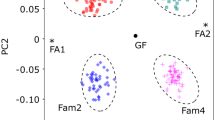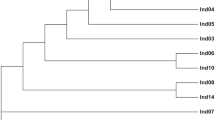Abstract
Mitochondrial DNA (mtDNA) has been used extensively in animals for phylogenetic and population studies but it has been applied only occasionally to mating systems analysis, where nuclear markers are usually preferred. We used denaturing-high performance liquid chromatography (D-HPLC) to detect mitochondrial DNA polymorphisms to assess the genetic mating system in Syngnathus abaster. Our study of ten pregnant males, revealed polygyny in 30% of the males, who carried embryos originating from multiple females. In addition, 30% of the pregnant males carried embryos with the same mitochondrial haplotype. This is not sufficient to demonstrate polyandry but allows a rapid selection and a reduced sample size for further studies. In conclusion, the proposed technique is time- and cost-effective, allows the certain identification of polygyny and provides useful information to study polyandry.

Similar content being viewed by others
References
Anderson M (2005) Evolution of classical polyandry: three steps to female emancipation. Ethology 111:1–23
Avise J, Arnold J, Ball RM, Bermingham E, Lamb T, Neigel JE, Reeb CA, Saunders NC (1987) Intraspecific phylogeography: the molecular bridge between population genetics and systematics. Annu Rev Ecol Syst 18:489-522
Berglund A, Rosenqvist G (2003) Sex role reversal in pipefish. Adv Stud Behav 32:131–167
Berglund A, Rosenqvist G, Svensson I (1986) Reversed sex roles and parental energy investment in zygotes of two pipefish (Syngnathidae) species. Mar Ecol-Prog Ser 29:209–215
Berglund A, Rosenqvist G, Svensson I (1989) Reproductive success of females limited by males in two pipefish species. Am Nat 133:506–516
Blumer LS (1979) Male parental care in the bony fishes. Q Rev Biol 54:149–161
Blumer LS (1982) A bibliography and categorization of bony fishes exhibiting parental care. Zool J Linn Soc 76:1–22
Breder CM Jr, Rosen DE (1966) Modes of reproduction in fishes. Natural History Press, New York
Brown WM, Prager EM, Wang A, Wilson AC (1982) Mitochondrial DNA sequences of primates: tempo and mode of evolution. J Mol Evol 18:225–239
Carew ME, Tay WT, Crozier RH (1997) Polygyny via unrelated queens indicated by mitochondrial DNA variation in the Australian meat ant Iridomyrmex purpureus. Insect Soc 44:7–14
Carcupino M, Baldacci A, Mazzini M, Franzoi P (2002) Functional significance of the male brood pouch in the reproductive strategies of pipefishes and seahorses: a morphological and ultrastructural comparative study on three anatomically different pouches. J Fish Biol 61:1465–1480
Clayton DA (1984) Transcription of the mammalian mitochondrial genome. Annu Rev Bioch 53:573–594
Haig SM, Mace TR, Mullins TD (2003) Parentage and relatedness in polyandrous comb crested jacanas using ISSRs. J Hered 94:302–309
Hall TA (1999) BioEdit: a user-friendly biological sequence alignment editor and analysis program for Windows 95/98/NT. Nucleic Acids Symp 41:95–98
Horai S, Hayasaka K, Kondo R, Tsugane K, Takahata N (1995) Recent African origin of modern humans revealed by complete sequences of hominoid mitochondrial DNAs. Proc Natl Acad Sci USA 92:532–536
Ishikawa S, Kimura Y, Tokai T, Tsukamoto K, Nishida M (2000) Gene rearrangement around the control region in the mitochondrial genome of conger eel Conger myriaster. Fish Sci 66:1186–1188
Jones AG, Avise JC (1997a) Microsatellite analysis of maternity and the mating system in the Gulf pipefish Syngnathus scovelli, a species with male pregnancy and sex-role reversal. Mol Ecol 6:203–213
Jones AG, Avise JC (1997b) Polygynandry in the dusky pipefish Syngnathus floridae revealed by microsatellite DNA markers. Evolution 51:1611–1622
Jones AG, Avise JC (2001) Mating systems and sexual selection in male-pregnant pipefishes and seahorses: insights from microsatellite-based studies of maternity. J Hered 92:150–158
Jones AG, Kvarnemo C, Moore GI, Simmons LW, Avise JC (1998) Microsatellite evidence for monogamy and sex-biased recombination in the Western Australian seahorse Hippocampus angustus. Mol Ecol 7:1497–1505
Jones AG, Rosenqvist G, Berglund A, Avise JC (1999) The genetic mating system of a sex-role-reversed pipefish (Syngnathus typhle): a molecular inquiry. Behav Ecol Sociobiol 46:357–365
Jones AG, Rosenqvist G, Berglund A, Avise JC (2000) Mate quality influences multiple maternity in the sex-role-reversed pipefish Syngnathus typhle. Oikos 90:321–326
Jones AG, Walker DE, Avise JC (2001) Genetic evidence for extreme polyandry and extraordinary sex-role reversal in a pipefish. Proc R Soc Lond B Biol 268:2531–2535
Jones AG, Moore GI, Kvarnemo C, Walker DE, Avise JC (2003) Sympatric speciation as a consequence of male pregnancy in seahorses. Proc Natl Acad Sci USA 100:6598–6603
Kocher TD, Thomas WK, Meyer A, Edwards SV, Pääbo S, Villablanca FX, Wilson AC (1989) Dynamics of mitochondrial DNA evolution in animals: amplification and sequencing with conserved primers. Proc Natl Acad Sci USA 86:6196–6200
Kosaki K, Udaka T, Okuyama T (2005) DHPLC in clinical molecular diagnostic services. Mol Genet Metab 86:117–123
Kvarnemo C, Moore GI, Jones AG, Nelson WS, Avise JC (2000) Monogamous pair bonds and mate switching in the Western Australian seahorse Hippocampus subelongatus. J Evol Biol 13:882–888
McCoy EE, Jones AG, Avise JC (2001) The genetic mating system and tests for cuckoldry in a pipefish species in which males fertilize eggs and brood offspring externally. Mol Ecol 10:1793–1800
Oefner PJ, Underhill PA (1995) Comparative DNA sequencing by denaturing high performance liquid chromatography (DHPLC). Am J Hum Genet 57:A266
Ribble DO (1990) The monogamous mating system of Peromyscus californicus as revealed by DNA fingerprinting. Behav Ecol Sociobiol 29:161–166
Saccone C, Pesole G, Sbisà E (1991) The main regulatory region of mammalian mitochondrial DNA: structure-function model and evolutionary pattern. J Mol Evol 33:83–91
Semino O, Passarino G, Oefner PJ, Lin AA, Arbuzova S, Beckman LE, De Benedictis G, Francalacci P, Kouvatsi A, Limborska S, Marcikiae M, Mika A, Mika B, Primorac D, Santachiara-Benerecetti AS, Cavalli-Sforza LL, Underhill PA (2000) The genetic legacy of Paleolithic Homo sapiens in extant Europeans: a Y chromosome perspective. Science 290:1155–1159
Silva K, Monteiro NM, Vieira MN, Almada VC (2006) Reproductive behavior of the black-striped pipefish Syngnathus abaster (Pisces; Syngnathidae). J Fish Biol 69:1860–1869
Stille M, Stille B (1992) Intra- and inter-nest variation in mitochondrial DNA in the polygynous ant Leptothorax acervorum (Hymenoptera; Formicidae). Insect Soc 39:335–340
Stoneking M, Hedgecock D, Higuchi RG, Vigilant L, Erlich HA (1991) Population variation of human mtDNA control region sequences detected by enzymatic amplification and sequence-specific oligonucleotide probes. Am J Hum Genet 48:370–382
Taylor MI, Morley JI, Rico C, Balshine S (2003) Evidence for genetic monogamy and female-biased dispersal in the biparental mouthbrooding cichlid Eretmodus cyanostictus from Lake Tanganyika. Mol Ecol 12:3173–3177
Teske PR, Cherry MI, Matthee CA (2003) Population genetics of the endangered Knysna seahorse, Hippocampus capensis. Mol Ecol 12:1703–1715
Teske PR, Cherry MI, Matthee CA (2004) The evolutionary history of seahorses (Syngnathidae: Hippocampus): molecular data suggest a West Pacific origin and two invasions of the Atlantic Ocean. Mol Phylogenet Evol 30:273–286
Tomasini JA, Quignard JP, Capapé C, Bouchereau JL (1991) Facteurs du success reproductif de Syngnathus abaster Risso, 1826 (Pisces, Teleostei, Syngnathidae) en milieu lagunaire méditerranéen (lagune de Mauguio, France). Acta Oecol 12:331–355
Underhill PA, Jin L, Lin AA, Mehdi SQ, Jenkins T, Vollrath D, Davis RW, Cavalli-Sforza LL, Oefner PJ (1997) Detection of numerous Y chromosome biallelic polymorphisms by denaturing high-performance liquid chromatography. Genome Res 7:996–1005
Underhill PA, Shen P, Lin AA, Jin L, Passarino G, Yang WH, Kauffman E, Hurlbut A, Bonné-Tamir B, Bertranpetit J, Francalacci P, Ibrahim M, Jenkins T, Kidd JR, Mehdi SQ, Seielstad MT, Wells RS, Piazza A, Soergel D, Sherry S, Feldman MW, Davis RW, Cavalli-Sforza LL, Oefner PJ (2000) Y Chromosome variation and the history of human populations. Nat Genet 26:358–361
Vincent A, Ahnesjö I, Berglund A, Rosenqvist G (1992) Pipefishes and seahorses: are they all sex role reversed? Trends Ecol Evol 7:237–241
Weber J L, Wong C (1993) Mutation of human short tandem repeats. Hum Mol Genet 2:1123–1128
William J, Ballard JWO, Kreitman M (1995) Is mitochondrial DNA a strictly neutral marker? Trends Ecol Evol 10:485–488
Wilson AB (2006) Interspecies mating in sympatric species of Syngnathus pipefish. Mol Ecol 15:809–824
Wilson AB, Vincent A, Ahnesjö I, Meyer A (2001) Male pregnancy in seahorses and pipefishes (family Syngnathidae): rapid diversification of paternal brood pouch morphology inferred from a molecular phylogeny. J Hered 92:159–166
Wilson AB, Ahnesjö I, Vincent A, Meyer A (2003) The dynamics of male brooding, mating patterns, and sex-role in pipefish and seahorses (Family Syngnathidae). Evolution 57:1374–1386
Acknowledgments
We thank Francesco Cucca and Daniela Contu (Dipartimento di Scienze Biomediche e Biotecnologie, Università di Cagliari) for help in D-HPLC analysis, and Tiziana Lai for useful discussion on DNA extraction. This work was supported by Interreg III and MURST (ex-60%) grants to MC and PF.
Author information
Authors and Affiliations
Corresponding author
Additional information
Communicated by U. Sommer.
Rights and permissions
About this article
Cite this article
Sanna, D., Addis, A., Biagi, F. et al. mtDNA control region and D-HPLC analysis: a method to evaluate the mating system in Syngnathidae (Teleostei). Mar Biol 153, 269–275 (2008). https://doi.org/10.1007/s00227-007-0810-1
Received:
Accepted:
Published:
Issue Date:
DOI: https://doi.org/10.1007/s00227-007-0810-1




